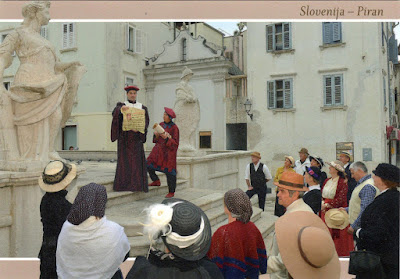 |
| 3183 Piran - Fisherman square, next to the town's inner port (mandracchio) |
Worldwide, for populations that inhabit the coasts of the seas and oceans, fishing is one of the main occupations of ancient times. In
Slovenian Istria, however, historical and political developments have radically and definitively changed the situation.
For many hundreds of years, the population of Piran was predominantly Italian, but in 1954 the town was transffered to
Yugoslavia,
the result being a massive exodus of Italian-speaking inhabitants. The new Comunist government of Yugoslavia sought to replace the old population with immigrants, so several traditional economic trades, among which are fishing, started to dissapear.
 |
| 3186 Piran - Fisherman repairing a fishing net |
In the 1980's, the number of fishermen increased, and the statistics for 1996 demonstrate that there were 40 fishermen in Piran, whose only sourse of income was fishing, and 39 persons who engaged in fishing as their secondary activity. Following the breakup of Yugoslavia in 1991, and the establishment of the new state border between Slovenia and
Croatia, new problems arose for the fishermen from Slovenia, who lost some resourses in the now croatian waters, where they used to fish, and had to adapt their strategies in various ways. One of these is the strategy of connecting fishing with tourism.






































